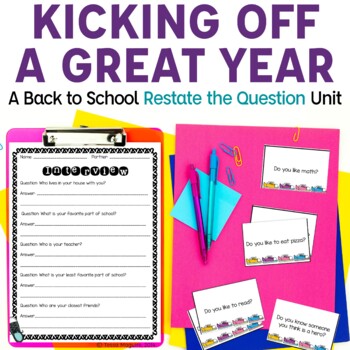An Introduction to Restate the Question Oral Language |
- PDF
What educators are saying
Also included in
- Looking to incorporate Restate the Question practice into your instruction? These reading comprehension activities practice answering questions in complete sentences while restating the question. Use the strategy posters to teach your students to use PQA or Turn the Question Around (TTQA). Use the OPrice $18.99Original Price $25.00Save $6.01
Description
This Getting to Know You Restating the Question unit gives students practice responding to questions in complete sentences through Back to School activities like morning meetings and student interviews. Restating the Question while answering questions is a difficult skill for many students. Introducing it through oral language is a great way to provide scaffolds and set the expectation of answering in complete sentences all year long. Use it during Back to School and during your morning meeting or community circle all year long!
WHAT'S INCLUDED:
- 128 question cards- some with restate the question scaffolds, some without
- Student interview templates with and without scaffolds
- About Me writing pages with and without scaffolds
The question cards can be used as a classroom greeting or part of morning meeting. Some cards include sentence stems for responses, while others expect students to know how to respond in a complete sentence independently. The different sets let you gradually increase the complexity with students.
The student interview templates include writing lines for a variety of grades. Whether you're in first grade or third grade, the student interview can be done by students independently through scaffolding.
This is also a great resource for ESL/ELD students. It helps them build syntax understanding as well as conversational skills.
READ WHAT BUYERS HAVE HAD TO SAY ABOUT IT:
★ "This resource made it easy to introduce students to how to properly answer a question! It was really great preparation for when students cited text evidence."
★ "Making students speak in sentences helps create the habit so when it is time to write sentences, it is an automatic skill. Great resource!"
★ "I used this product to teach my students how to write a complete sentence and how to respond to question during reading comprehension. I cut out the cards and put them into envelopes for at home practice as well as morning meeting discussion. Great product, it really did help. "
★ "I totally recommend this product! It has been very instrumental in helping my students to restate the question! Thanks!"
CLICK HERE to follow me and be notified of future products as soon as they are posted.
_______________________________________________________________
Copyright © Tessa Maguire.
Purchase is for single classroom use only. Please purchase additional licenses if you intend to share this product with colleagues.
You may not redistribute, edit, sell, or otherwise post this product on the internet. You may, however, post a link for others to purchase themselves.






